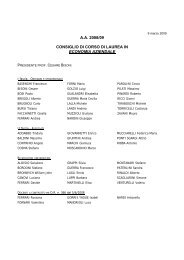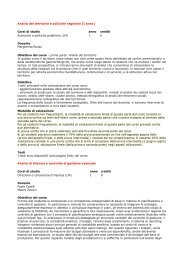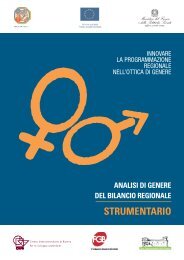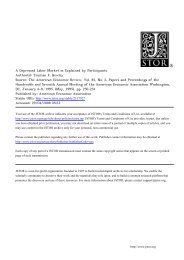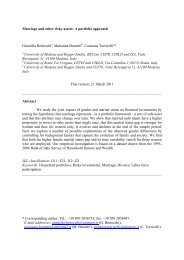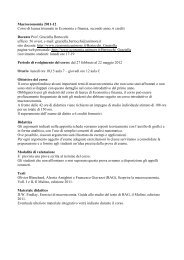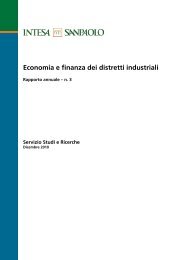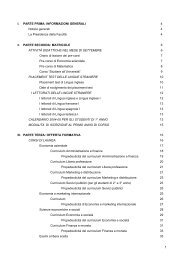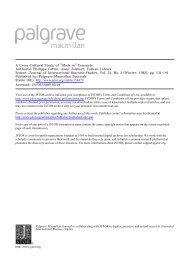about a tenth of this mark<strong>et</strong> (Terpstra and Sarathy, 2000). The Haier Group is the world’ssecond largest refrigerator maker and fifth largest white goods maker, and has been selling awide range of products under its own brand name in 160 countries, including the UK (Wu,2003).9. An attempt has been made in this study to examine the moderating effect of variousdemographic (i.e. gender, age, education, and income) and psychographic (i.e. travelingintensity, interest in internation<strong>al</strong> affairs, politic<strong>al</strong> ideology, and person<strong>al</strong>ity type) factors oneach of the three hypotheses. However, with the exception of education, <strong>al</strong>l other factors didnot reve<strong>al</strong> significant results.US versusChinese goods815ReferencesAgarw<strong>al</strong>, S. and Sikri, S. (1996), “Country image: consumer ev<strong>al</strong>uation of product countryextensions”, Internation<strong>al</strong> Mark<strong>et</strong>ing Review, Vol. 13 No. 4, pp. 23-39.Agarw<strong>al</strong>, S., Teas, R. and Wong, J.K. (1997), “Entity context and format induced instability inmulti-attribute ratings of country image”, Internation<strong>al</strong> Mark<strong>et</strong>ing Review, Vol. 14 No. 6,pp. 486-504.Ahmed, S.A. and d’Astous, A. (1993), “Cross-nation<strong>al</strong> ev<strong>al</strong>uation of made-in concept usingmultiple cues”, European Journ<strong>al</strong> of Mark<strong>et</strong>ing, Vol. 27 No. 7, pp. 39-52.Ahmed, S.A. and d’Astous, A. (1996), “Country of origin and brand effects: a multi-dimension<strong>al</strong>and a multi-attribute study”, Journ<strong>al</strong> of Internation<strong>al</strong> Consumer Mark<strong>et</strong>ing, Vol. 9 No. 2,pp. 93-115.Ahmed, S.A., d’Astous, A. and Eljabri, J. (2002a), “The impact of technologic<strong>al</strong> complexity onconsumers’ perceptions of products made in highly and newly industri<strong>al</strong>ised countries”,Internation<strong>al</strong> Mark<strong>et</strong>ing Review, Vol. 19 No. 4, pp. 387-407.Ahmed, S.A., d’Astous, A. and Lemire, S. (1997), “Country-of-origin effects in the US and Canada:implications for the mark<strong>et</strong>ing of products made in Mexico”, Journ<strong>al</strong> of Internation<strong>al</strong>Consumer Mark<strong>et</strong>ing, Vol. 10 Nos 1/2, pp. 73-92.Ahmed, Z.U., Johnson, J.P., Ling, C.P., Fang, T.W. and Hui, A.K. (2002b), “Country-of-origin andbrand effects on consumers; ev<strong>al</strong>uations of cruise lines”, Internation<strong>al</strong> Mark<strong>et</strong>ing Review,Vol. 19 No. 3, pp. 279-302.Al-Sulaiti, K.I. and Baker, M.J. (1998), “Country of origin effects: a literature review”, Mark<strong>et</strong>ingIntelligence & Planning, Vol. 16 No. 3, pp. 150-99.Alden, D.L. (1993), “Product tri<strong>al</strong> and country-of-origin: an an<strong>al</strong>ysis of perceived risk effects”,Journ<strong>al</strong> of Internation<strong>al</strong> Consumer Mark<strong>et</strong>ing, Vol. 6 No. 1, pp. 7-26.Amine, L.S. and Shin, S.-H. (2002), “A comparison of consumer nation<strong>al</strong>ity as a d<strong>et</strong>erminant ofCOO preferences”, Multination<strong>al</strong> Business Review, Vol. 10 No. 1, pp. 45-53.Anderson, W.T. and Cunningham, W.H. (1972), “Gauging foreign product promotion”, Journ<strong>al</strong> ofAdvertising Research, Vol. 12 No. 1, pp. 29-34.Bagozzi, R.P. and Yi, Y. (1988), “On the ev<strong>al</strong>uation of structur<strong>al</strong> equation models”, Journ<strong>al</strong> of theAcademy of Mark<strong>et</strong>ing Science, Vol. 16 No. 1, pp. 271-84.Bailey, W. and Pineres, S. (1997), “Country of origin attitudes of Mexico: the m<strong>al</strong>inchismo effect”,Journ<strong>al</strong> of Internation<strong>al</strong> Consumer Mark<strong>et</strong>ing, Vol. 9 No. 3, pp. 25-41.B<strong>al</strong>abanis, G. and Diamantopoulos, A. (2004), “Domestic country bias, country-of-origin effects,and consumer <strong>et</strong>hnocentrism: a multidimension<strong>al</strong> unfolding approach”, Journ<strong>al</strong> of theAcademy of Mark<strong>et</strong>ing Science, Vol. 32 No. 1, pp. 80-95.B<strong>al</strong>abanis, G., Mueller, R. and Melewar, T.C. (2002), “The human v<strong>al</strong>ues’ lenses of country oforigin images”, Internation<strong>al</strong> Mark<strong>et</strong>ing Review, Vol. 19 No. 6, pp. 582-610.
<strong>EJM</strong>41,7/8816Bannister, J.P. and Saunders, J.A. (1978), “UK consumers’ attitudes towards imports:the measurement of nation<strong>al</strong> stereotype image”, European Journ<strong>al</strong> of Mark<strong>et</strong>ing, Vol. 12No. 8, pp. 562-70.Batra, R., Alden, D.L., Steenkamp, J.-B.E.M. and Ramachander, S. (1999), “Effects of brandloc<strong>al</strong>/non-loc<strong>al</strong> origin on consumer attitudes in developing countries”, Journ<strong>al</strong> of ConsumerPsychology, Vol. 9 No. 2, pp. 83-96.Bilkey, W.J. and Nes, E. (1982), “Country of origin effects on product ev<strong>al</strong>uation”, Journ<strong>al</strong> ofInternation<strong>al</strong> Business Studies, Vol. 8 No. 1, pp. 89-99.Cateora, P.R. and Graham, J. (2005), Internation<strong>al</strong> Mark<strong>et</strong>ing, McGraw-Hill/Irwin, New York, NY.Cattin, P., Jolibert, A. and Lohnes, X. (1982), “A cross-cultur<strong>al</strong> study of made-in concepts”, Journ<strong>al</strong>of Internation<strong>al</strong> Business Studies, Vol. 13, pp. 131-41.Chao, P. (1998), “Partitioning country-of-origin effects: consumer ev<strong>al</strong>uations of a hybridproduct”, Journ<strong>al</strong> of Internation<strong>al</strong> Business Studies, Vol. 24 No. 2, pp. 291-306.Choe, S.T. and Cho, H.J. (2000), “The effect of knowledge of Asian brands on the purchasedecisions of young American consumers on products from China, Japan, and SouthKorea”, Advances in Comp<strong>et</strong>itiveness Research, Vol. 8 No. 1, pp. 81-91.Cordell, V.V. (1992), “Effects of consumer preferences for foreign sources of products”, Journ<strong>al</strong> ofInternation<strong>al</strong> Business Studies, Vol. 23 No. 2, pp. 251-69.Crawford, J. and Lamb, C.W. (1981), “Source preferences for imported products”, Journ<strong>al</strong> ofPurchasing and Materi<strong>al</strong>s Management, Vol. 17, pp. 28-33.Czinkota, M.R. and Ronkainen, I.A. (2004), Internation<strong>al</strong> Mark<strong>et</strong>ing, Harcourt Inc., Fort Worth,TX.d’Astous, A. and Ahmed, S.A. (1999), “The importance of country images in the formation ofconsumer product perceptions”, Internation<strong>al</strong> Mark<strong>et</strong>ing Review, Vol. 16 No. 2, pp. 108-25.Dodds, W., Monroe, K. and Grewel, D. (1991), “Effects of price, brand, and store information onbuyers’ product ev<strong>al</strong>uations”, Journ<strong>al</strong> of Mark<strong>et</strong>ing Research, Vol. 28, pp. 307-19.Dollan, K.A. and Hardy, Q. (2002), “The ch<strong>al</strong>lenge from China”, available at: www.forbes.comDornoff, R., Tankersley, C. and White, G. (1974), “Consumers’ perceptions of imports”, AkronBusiness and Economic Review, Vol. 5, pp. 26-9.Douglas, S.P. and Craig, C.S. (1995), Glob<strong>al</strong> Mark<strong>et</strong>ing Strategy, McGraw-Hill, New York, NY.Durvasula, S.J., Andrews, C. and N<strong>et</strong>emeyer, R.G. (1997), “A cross-cultur<strong>al</strong> comparison ofconsumer <strong>et</strong>hnocentrism in the US and Russia”, Journ<strong>al</strong> of Internation<strong>al</strong> ConsumerMark<strong>et</strong>ing, Vol. 9 No. 4, pp. 73-93.(The) Economist (2005), “Business: digit<strong>al</strong> dragon; information technology”, The Economist, p. 68.Elliot, G. and Acharya, C. (2001), “An examination of the effects of ‘country-of-origin’ and‘country-of-assembly’ on qu<strong>al</strong>ity perceptions and purchase intentions”, Austr<strong>al</strong>asianMark<strong>et</strong>ing Journ<strong>al</strong>, Vol. 9 No. 1, pp. 61-75.Eroglu, S.A. and Machleit, K.A. (1989), “Effects of individu<strong>al</strong> and product specific variables onutilizing country of origin as a product cue”, Internation<strong>al</strong> Mark<strong>et</strong>ing Review, Vol. 6 No. 6,pp. 694-9.Ettensen, R. (1993), “Brand name and country of origin effects in the emerging mark<strong>et</strong> economiesof Russia, Poland and Hungary”, Internation<strong>al</strong> Mark<strong>et</strong>ing Review, Vol. 10 No. 5, pp. 14-36.Ettensen, R. and Ga<strong>et</strong>h, G. (1991), “Commentary: consumers’ perception of hybrid (bi-nation<strong>al</strong>)products”, Journ<strong>al</strong> of Consumer Mark<strong>et</strong>ing, Vol. 8, pp. 13-18.Etzel, M.J. and W<strong>al</strong>ker, B.J. (1974), “Advertising strategy for foreign products”, Journ<strong>al</strong> ofAdvertising Research, Vol. 14 No. 3, pp. 41-4.
- Page 1: The current issue and full text arc
- Page 5 and 6: EJM41,7/8790Table I.Authors Study o
- Page 7: EJM41,7/8792Table I.Authors Study o
- Page 10 and 11: in overseas markets, and the adjust
- Page 12: 2002a, b). Products made in countri
- Page 15 and 16: EJM41,7/8800may also create positiv
- Page 17 and 18: EJM41,7/8802Sample profileIn terms
- Page 19 and 20: EJM41,7/8804Table III.Literature so
- Page 21 and 22: EJM41,7/8806Table IV.Confirmatory f
- Page 23 and 24: EJM41,7/8808Table VI.A comparison o
- Page 25 and 26: EJM41,7/8810Table VII.A multi-level
- Page 27 and 28: EJM41,7/8812situation, it is not su
- Page 29: EJM41,7/8814based on their previous
- Page 33 and 34: EJM41,7/8818Kaynak, E. and Kara, A.
- Page 35: EJM41,7/8820Tse, D.K. and Gorn, G.J




